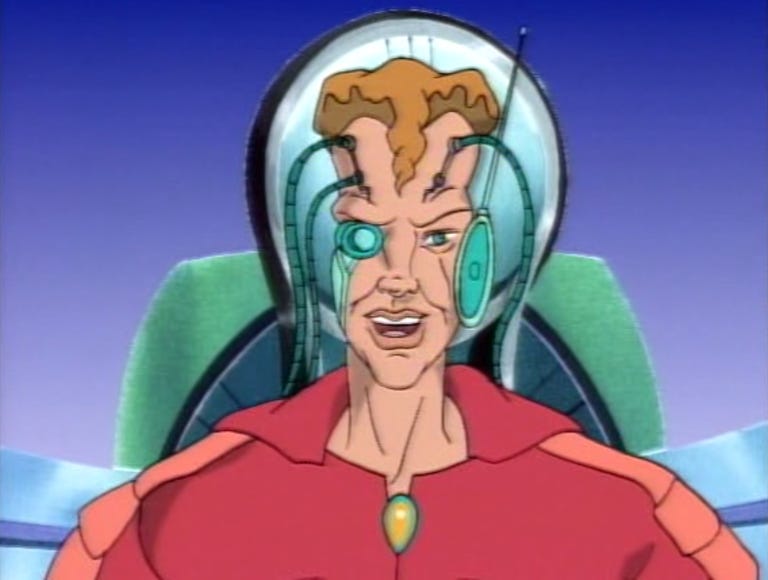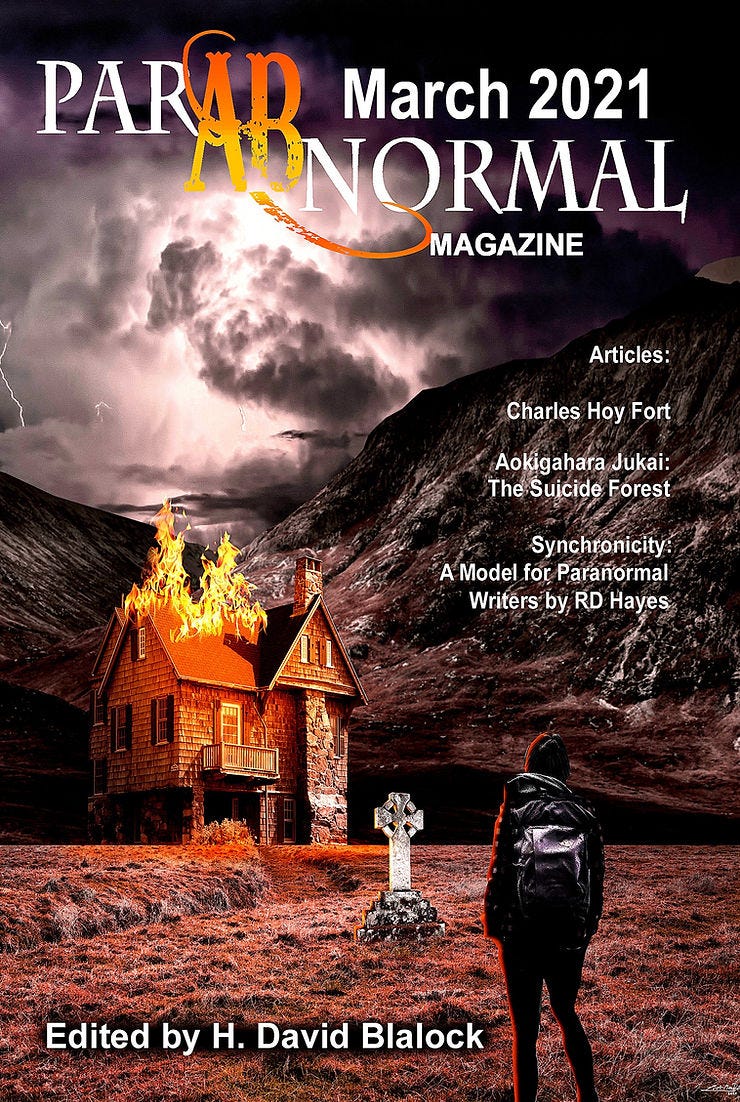There has been a long line of thought in human history—religious, humanistic, philosophical, scientific, aspirational—that wants us to believe that the truth lies beyond matter. Beyond the universe. In another dimension.
This belief makes us blind to the world.
-
, in a Note last MondayI came home from Mythic Con with a cold that lingered for almost a week, and now my wife seems to have the flu. The late winter weather has been alternately glorious and terrible (nickel-diameter hail last Sunday!), and the news is all bad, all the time. If it bleeds, it leads.
Welcome to Metropia

After Caped Crusader, which I wrote about last week, I revisited both Batman: the Animated Series and another Saturday morning show from the 90s, Phantom 2040. Designed by the same animator who made Aeon Flux, it is likewise not strictly a superhero show. It is more about the last-ditch efforts of the 24th Phantom’s motley humanist crew to hinder the world’s largest corporation Maximum Inc. from deliberately crashing the ecosystem so they can replace it with something simpler, something easier to manage and extract profit from. They of course plan to hide away inside Cyberville and upload their minds into computers and robots (never mind that the one person to do this went completely insane). It was supposed to be satirical, though it doesn’t feel that way today, 30 years later, with thoughts of the Singularity having escaped SF and now floating down the mainstream.
Critics and other artists loved it. From the Wikipedia article:
Along with Andrea Romano's equally pioneering work on Batman: The Animated Series, Stu Rosen's voice direction on Phantom 2040 had a lasting impact on animated adventure television. Romano and Rosen cast accomplished dramatic actors and introduced a new level of maturity and complexity to their show's vocal performances that set the standard for all TV animation that followed.
The fulcrum of the show is actually Ron Perlman’s character Hubert Graft, a combat hero of the Resource Wars whose mechanical body is the literal property of Maximum Inc. He currently serves as its security chief and principal Phantom-chaser. He is the only person in the whole show whose actions are not consistently good or evil. This is the main problem with the show, as of the end of Season 1. The supposedly main character, Scott Valentine’s Kit Walker, is too perfect.
It’s a brilliant setup, though, in terms of world-building. At the very heart of Metropia, where 16 years ago a train wreck created a toxic no-man’s land called Sector Zero, there is a thriving “ghostwood jungle” full of escaped and supposedly extinct zoo animals, quietly cleaning up the radioactive mess. What a metaphor to completely ignore in the ongoing story! Unfortunately, in my opinion, the writers were more interested in Heisenberg, the artificial man who is basically the Buddha of the Biots, awakening Metropia’s artificial slaves, who are then sometimes secretly replaced by unemployed humans wearing plastic biot shells.

Maybe they were saving the jungle for later. The series ran for 35 episodes, and I’m only 20 episodes in.
A Funny Thing Happened on Friendly Avenue
The show updated a lot of the tropes from the newspaper comics. The love interest became a cop in power armor (played by Leah Remini), and Devil the wolf became her cyberdog partner DVL. The Phantom’s white horse Hero became a black Ford Mustang that could transform into a purple aircar.
So I was driving over to What the Hell Con at Guilford College on Friday the 14th, hoping to run a game of Blades in the Dark set in Middle-Earth,
when what should roar past me but a purple Mustang?!?1
Not Just a Police Song
Many miles away
There's a shadow on the door
Of a cottage on the shore
Of a dark Scottish lake
-Synchronicity II
I have a long-standing interest in such strange coincidences.

It started during my extremely boring chemistry class in high school. I noticed that whenever I caught myself looking at my digital watch or the analog electrical clock on the wall, it always seemed to be 11:11. I don’t wear a watch anymore (who does?), and many of the wall clocks at UNCG seem to be unplugged, but that number still appears to me with some mildly disturbing regularity.
My limited experiments with the phenomenon show that the more attention I pay to weird coincidences, the more of them I experience. It’s like dream journaling. The more I document my dreams, the better my dream recall gets (though I still never seem to break through to full-on lucid dreaming). When I stop journaling, they fade into the background.
I mention this because I recently ran across this Substack by
.She is doing an experiment in crowdsourced writing. I sent her the Mustang anecdote above to see if she will in fact draw it out of a hat and incorporate it into one of her 297-word essays.
I should be clear that I do not personally agree with her Premise 2, specifically the bolded part.
Premise 2: The ideas that really matter don’t originate in human heads. They are dreamt up by the gods, and they migrate through the imaginal realm before arriving in material reality. We can learn to access the imaginal realm and receive the ideas that really matter.
I personally subscribe to a more bottom-up form of memetics, where ideas assemble themselves like atoms and molecules do, with no need for dreaming gods. I titled a 2016 piece for Intergalactic Medicine Show “Spelunking the Noosphere” as a joke. I don’t see it as a separate nonmaterial realm but as a layer of the very same complex reality that we inhabit.2
I do fully agree with Eleanor that we’re in a moment where our now globalized western society’s “consciousness contract” (our collective mental model of what consciousness is, and what it means) is being consciously and unconsciously renegotiated, like the Earth’s magnetic field reorganizing itself beneath our feet.
… we have a very important role right now. In order to honour this expansion of consciousness that’s playing out inside each of us, we have to indulge our deepest weirdness; we have to get skilled at hearing the urgings of our instincts and subconsciouses. We each have to celebrate and elevate our specific weirdness.
And we have to advance with absolute intellectual rigour. We have to bring the intellect along with us, meet its need for context and information and serious thought—so that our rational minds (and those of our neighbours) don’t pit themselves against us …
Human minds align themselves into social movements like iron atoms align themselves along magnetic field lines that are themselves just summations of the alignments of individual atoms.
Maybe that’s what Eleanor’s gods are? Field lines of consciousness?
Just a thought.
The World is Not Broken, Either
There’s a concept in Judaism called tikkun olam, “repairing the world,” originally a way to keep people paying their debts, that has morphed and grown into an overall feeling that isn’t quite apocalyptic, but shares the sentiment that the world used to be perfect until we tragically flawed humans broke it3. That’s the same sentiment that informs the modern, supposedly secular environmental movement, as well as entertainments like Phantom 2040.
Buddhism has quite a different understanding of our world and its ongoing problems difficulties.
The leading characteristic of life in its myriad forms is the battle – that which Darwin called ‘the Struggle for Existence’. Before proceeding further it is important to distance ourselves from a common use of the expression ‘broken’ or ‘ravaged’ by concerned nature-lovers and others distressed at the planetary destruction going on due to man’s greed and insensitivity. Such assaults on the biosphere are nothing new and the history of our planet is replete with instances of vast destruction.
The Permian extinction was definitely not our fault. We weren’t even here. The K-T asteroid and the extinction of the dinosaurs (except for birds) were also not our fault.
The ‘brokenness’ that we highlight is a feature of life in a world that spawns us in order to defeat and kill us. The writer and philosopher Albert Camus sees ‘absurdity’ as the best descriptive word to summarize our overall plight as hapless captives briefly nurtured and then pushed into decay and oblivion.
Except that’s not right, either. We’re not entirely helpless. We can and do react to our situations, and if we’re paying attention, we can choose how to react. Maybe those actions and reactions will add up to something, like the Montreal Protocol that phased out CFCs, or the game-based charities I mentioned last week; maybe they won’t. There’s only one way to find out, and that’s to do the experiment of trying.
SpecFic Fandom is currently just a local in-person board game group on Facebook. What might it become?
“Purple isn't the most popular Mustang color over the years with only a handful of purple shades offered. Technically the first purple shade offered would have been the Evening Orchid color in 1967. The coolest purple offered on a Mustang is easily the Mystic color-changing hue that was hugely popular in the late 1990s. My personal favorite purple is the Metallic purple used in 1967.”
The database includes a search function for all the Mustang colors. Car nerds!
I riffed on this theme multiple times over the course of that column:
An idea which, it turns out, led a guy named Kook to advocate for the nation-state of Israel. I swear to you, I am not making that up. Our world is not broken; it’s absurd.




Humans weren’t always agents of destruction. Apparently, we helped reforest the planet after the last Ice Age. Humans traveled with their habitats bringing seeds wherever they went. It’s all in the way we view the world and our role in this ecosystem. Learning to once again appreciate and respect the life that surrounds us would go a long way. Thanks for the mention 🙏.